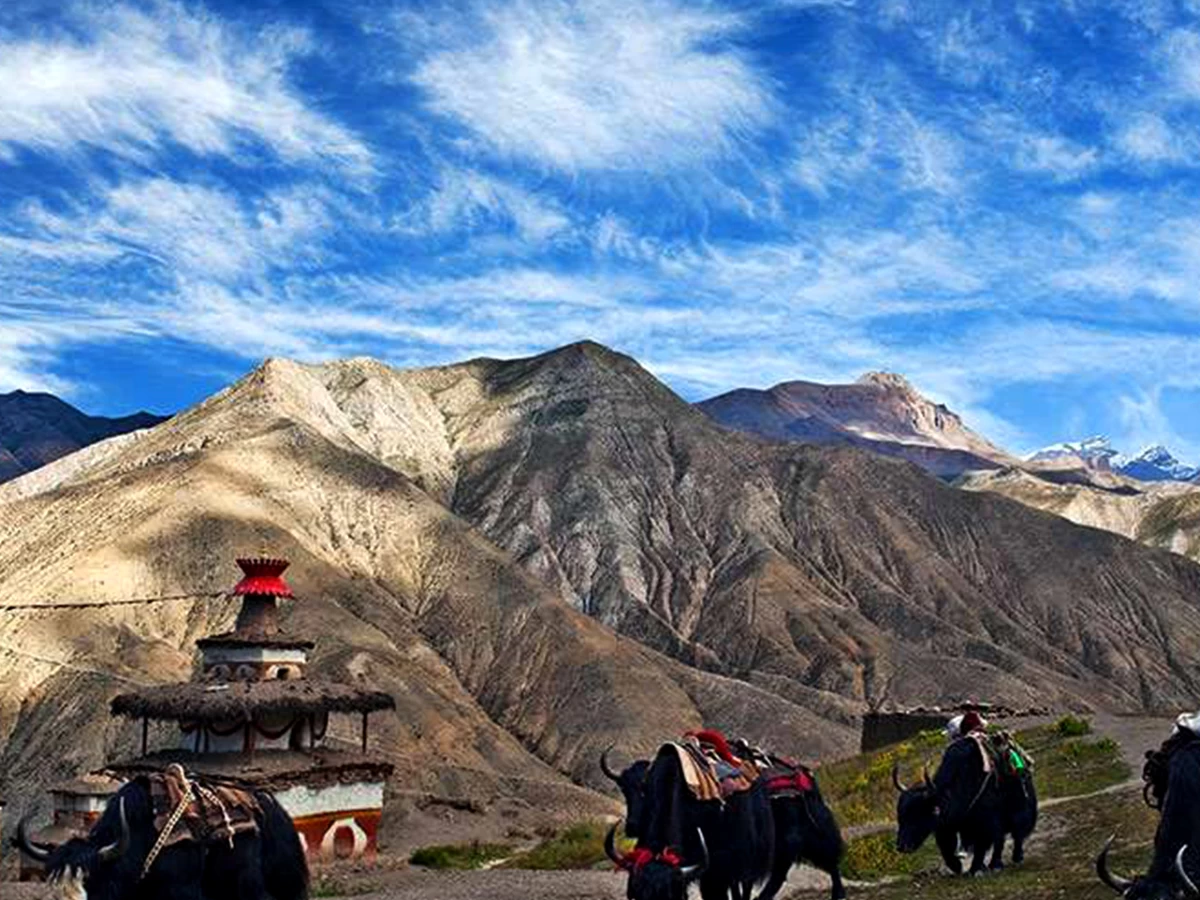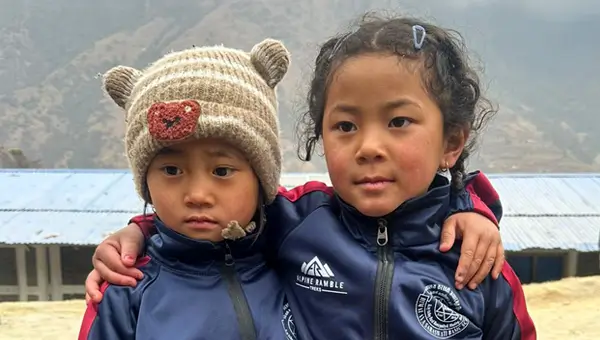“Upper Dolpo Trek into the far west of Nepal to discover the magic of the untouched Himalayas: a breathtaking region of wild mountain landscapes and ancient monasteries—with nary a tourist in sight.”
Embark upon an unforgettable adventure in the remote Upper Dolpo
Are you ready for a true adventure? In the far western reaches of Nepal’s Himalayas, close to the border with the high-altitude Tibetan plateau, you’ll find the spectacular Upper Dolpo.
This is a semi-arid region of tall mountains, remote villages, historic monasteries, and impossibly beautiful alpine trails. The Upper Dolpo was perhaps best memorialized in Peter Matthiessen’s seminal travel memoir, The Snow Leopard—but few travelers have had the privilege of trekking in this remarkable part of Nepal for themselves.
The Upper Dolpo Trek still represents a path of mystery and adventure, especially when compared with some of the most popular treks in Nepal. In fact, it wasn’t until 1989 that the entire region was first opened to trekkers and foreign travelers.
Since that time, the Upper Dolpo has beckoned to hikers who hear the call to adventure—will you join their ranks?
What can you expect on the Upper Dolpo Trek?
Trekking in Nepal has become more accessible than ever in recent years, thanks to modern infrastructure, regular flights to the furthest corners of the country, and a wide variety of trekking routes catering to novice and expert hikers alike.
However, the Upper Dolpo has long been something of an exception to this rule. Situated in Nepal’s western Himalayas, the region has always been more difficult to access than the most popular routes for trekking in Nepal, with a comparatively undeveloped tourism structure.
But we’re proud to report that this is changing: for our 24-day Upper Dolpo Trek, we’ve streamlined transportation to the trailhead, leveraging our expertise in the trekking industry to make your adventure as accessible as possible.
We’ve also arranged for comfortable teahouse-style accommodations on this trek, where possible; gone are the days when you needed to camp every night in the Upper Dolpo. While your trek in this part of Nepal will be as remote and exciting as you could desire, now you can enjoy it in relative comfort.
Experience the unique culture and history of the Upper Dolpo
Thanks to its remoteness in the western Himalayas, the Upper Dolpo has gone relatively unchanged for centuries.
Modernization has been slow to arrive in this part of Nepal, which means that travelers who are keen to encounter undiluted Buddhist culture will be thrilled to discover the Upper Dolpo Trek.
The area is considered culturally Tibetan, and it’s here that the pre-Buddhist religion known as Bön still thrives. We’ll visit monasteries associated with both faiths during the course of this 24-day trek, and we’ll also explore the wild landscapes of the Shey Phoksumdo National Park along the way.
After spending three weeks traversing this beautiful mountain territory, you’ll come to understand why locals have long identified it as a beyul, or hidden valley, where the spiritual and physical realms intersect with one another.
When you’re ready to embark upon your own trek in the Upper Dolpo, reach out to the team at Alpine Ramble Treks via WhatsApp at +977 9851175531.
Best Time of Year for the Upper Dolpo Trek
Trekking seasons in Nepal are largely dictated by the summer monsoon, and our Upper Dolpo Trek is no exception.
The monsoon typically lasts from June to August, and most visitors consequently choose to hike during the spring months of February to May or the autumn months of September to November.
These are the best times of year to enjoy the perfect combination of comfortable temperatures and clear mountain views. However, we may encounter heavy snowfall in the early spring and late fall on the Upper Dolpo trek, and this can make it all but impossible to cross the high mountain passes on this trekking route.
As such, late spring and early fall are the best seasons for this trek. Trekking in summer is also possible, but we generally recommend against tackling the Upper Dolpo Trek during Nepal’s snowbound winters. If you have any questions about the best time to trek in Nepal, please don’t hesitate to reach out to us.
Upper Dolpo Trek Difficulty
If you’re in good physical condition and have prepared for your adventure with regular cardiovascular exercise, trekking in the Upper Dolpo doesn’t require any special skills or mountaineering experience.
But this is a strenuous trek that involves approximately three weeks of hiking at high altitudes in remote territories, where access to modern amenities may be limited.
We’ll also be crossing multiple mountain passes at more than 5,000 meters in elevation, where the air is thin and it’s possible to contract symptoms of acute mountain sickness, or altitude sickness.
To mitigate the risk of having to turn back, we’ve constructed a carefully planned itinerary that will allow you plenty of time to acclimatize as we ascend higher and higher into the western Himalayas. Your experienced guide from Alpine Ramble Treks will also closely monitor the condition of every trekker in your party to ensure that your safety remains our first priority.
Other options for trekking Nepal
If you’re looking at the Upper Dolpo Trek, you’re probably interested in hiking routes with low crowd density, opportunities for authentic cultural encounters, and remote mountain scenery. Fortunately, Nepal has plenty of other options for you to consider.
Our two-week Upper Mustang Trek offers the chance to explore an untouched region of striking beauty, where the ancient walled city of Lo Manthang watches over the deserts and mountains of a former Trans-Himalayan kingdom.
And if you’re looking for something a bit more accessible, the Helambu Circuit Trek is a rewarding trek to consider—while it starts within just a stone’s throw of Kathmandu, its trails are remarkably crowd-free when compared to our more popular offerings, like the Everest Base Camp Trek.
Cost for the Upper Dolpo trek in March-May and September to December 2024,2and 2026
| No. of Group | Pprice in USD Per person | Booking Status |
| 2 | 4900 | Inquiry / Book Now |
| 3-5 | 4500 | Inquiry / Book Now |
| 6-15 | 3990 | Inquiry / Book Now |
Highlights
- Feast your eyes on awe-inspiring views of Nepal’s Trans-Himalayan mountains and deserts.
- Marvel at the mesmerizing azure waters of the alpine Phoksundo Lake.
- Trek into the heart of the remote western Himalayas, where Buddhism and Bön faiths flourish side-by-side.
- Get up close and personal with the Upper Dolpo’s most sacred peak: Crystal Mountain.
- Enjoy an exciting combination of camping and teahouse-style accommodations on our carefully crafted version of the Upper Dolpo Trek.
Additional Benefits of this Trek with Alpine Ramble
- Free transfers to and from Tribhuvan International Airport upon arrival and departure.
- Complimentary use of any necessary trekking equipment, such as sleeping bags, down jackets, duffle bags, walkie-talkies, trekking poles, and an oximeter to monitor your oxygen and pulse.
- Fun souvenirs of your Himalayan adventure: a trekking route map, a t-shirt emblazoned with the Alpine Ramble Treks logo, and a hat!
Please note: The trekking times indicated below are approximate and are best used as general guidelines. During the Upper Dolpo Trek, you’ll be able to travel freely at your own pace.





